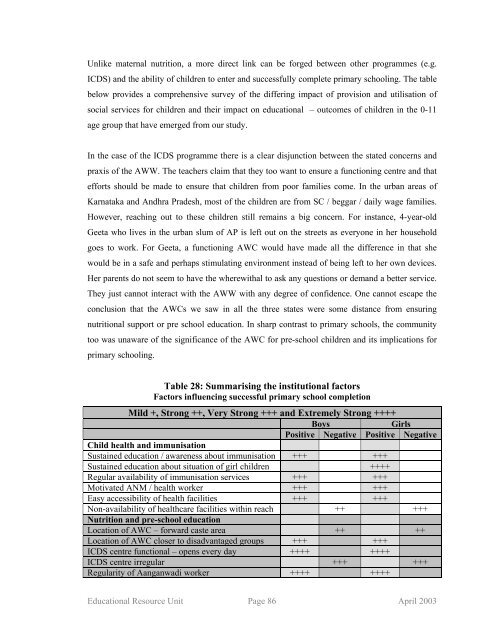Snakes and Ladders - ERU Consultants Pvt. Ltd.
Snakes and Ladders - ERU Consultants Pvt. Ltd.
Snakes and Ladders - ERU Consultants Pvt. Ltd.
Create successful ePaper yourself
Turn your PDF publications into a flip-book with our unique Google optimized e-Paper software.
Unlike maternal nutrition, a more direct link can be forged between other programmes (e.g.<br />
ICDS) <strong>and</strong> the ability of children to enter <strong>and</strong> successfully complete primary schooling. The table<br />
below provides a comprehensive survey of the differing impact of provision <strong>and</strong> utilisation of<br />
social services for children <strong>and</strong> their impact on educational – outcomes of children in the 0-11<br />
age group that have emerged from our study.<br />
In the case of the ICDS programme there is a clear disjunction between the stated concerns <strong>and</strong><br />
praxis of the AWW. The teachers claim that they too want to ensure a functioning centre <strong>and</strong> that<br />
efforts should be made to ensure that children from poor families come. In the urban areas of<br />
Karnataka <strong>and</strong> Andhra Pradesh, most of the children are from SC / beggar / daily wage families.<br />
However, reaching out to these children still remains a big concern. For instance, 4-year-old<br />
Geeta who lives in the urban slum of AP is left out on the streets as everyone in her household<br />
goes to work. For Geeta, a functioning AWC would have made all the difference in that she<br />
would be in a safe <strong>and</strong> perhaps stimulating environment instead of being left to her own devices.<br />
Her parents do not seem to have the wherewithal to ask any questions or dem<strong>and</strong> a better service.<br />
They just cannot interact with the AWW with any degree of confidence. One cannot escape the<br />
conclusion that the AWCs we saw in all the three states were some distance from ensuring<br />
nutritional support or pre school education. In sharp contrast to primary schools, the community<br />
too was unaware of the significance of the AWC for pre-school children <strong>and</strong> its implications for<br />
primary schooling.<br />
Table 28: Summarising the institutional factors<br />
Factors influencing successful primary school completion<br />
Mild +, Strong ++, Very Strong +++ <strong>and</strong> Extremely Strong ++++<br />
Boys Girls<br />
Positive Negative Positive Negative<br />
Child health <strong>and</strong> immunisation<br />
Sustained education / awareness about immunisation +++ +++<br />
Sustained education about situation of girl children ++++<br />
Regular availability of immunisation services +++ +++<br />
Motivated ANM / health worker +++ +++<br />
Easy accessibility of health facilities +++ +++<br />
Non-availability of healthcare facilities within reach ++ +++<br />
Nutrition <strong>and</strong> pre-school education<br />
Location of AWC – forward caste area ++ ++<br />
Location of AWC closer to disadvantaged groups +++ +++<br />
ICDS centre functional – opens every day ++++ ++++<br />
ICDS centre irregular +++ +++<br />
Regularity of Aanganwadi worker ++++ ++++<br />
Educational Resource Unit Page 86 April 2003












